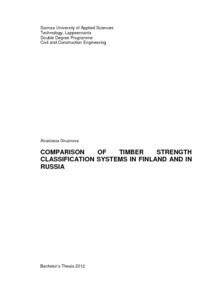Comparison of timber strength classification systems in Finland and in Russia
Gruznova, Anastasia (2012)
Gruznova, Anastasia
Saimaan ammattikorkeakoulu
2012
All rights reserved
Julkaisun pysyvä osoite on
https://urn.fi/URN:NBN:fi:amk-2012091013534
https://urn.fi/URN:NBN:fi:amk-2012091013534
Tiivistelmä
The purpose was to find out the way how to transfer Finnish strength classes into Russian ones, to study testing process of sawn timber elements and to investigate the current market of wooden products in both countries.
The theoretical part is a combination of background information about the features of timber as a construction material and a comparative analysis of grading of sawn timber in Russia and in Finland. The main issue was to find a correspondence between values given in the main normative documents about strength classification of sawn timber – Finnish EN 338 and Russian SNIP II-25-80. In addition the theoretical part includes a description of the existing strength determining tests in both countries. The empirical part consists of strength measurements carried out in Finnish and Russian laboratories. Samples made of Finnish timber C24 were used.
As a result of this project it could be stated that Finnish and Russian strength classifications are not the same, mainly because timber in Russia is commonly used as a finishing material. Therefore quality and appearance factors are important most of all. But there is a correspondence between Russian quality grades and Finnish strength ones. Russian and Finnish methods of laboratory strength determining differ in size and dimensions of samples, which means problems in using values from European standards in calculations according to Russian SNIPs. One way to facilitate and develop trade relations between Finland and Russia is to create a uniform base of normative documentation between Europe and Russia and synchronization methods of testing.
The theoretical part is a combination of background information about the features of timber as a construction material and a comparative analysis of grading of sawn timber in Russia and in Finland. The main issue was to find a correspondence between values given in the main normative documents about strength classification of sawn timber – Finnish EN 338 and Russian SNIP II-25-80. In addition the theoretical part includes a description of the existing strength determining tests in both countries. The empirical part consists of strength measurements carried out in Finnish and Russian laboratories. Samples made of Finnish timber C24 were used.
As a result of this project it could be stated that Finnish and Russian strength classifications are not the same, mainly because timber in Russia is commonly used as a finishing material. Therefore quality and appearance factors are important most of all. But there is a correspondence between Russian quality grades and Finnish strength ones. Russian and Finnish methods of laboratory strength determining differ in size and dimensions of samples, which means problems in using values from European standards in calculations according to Russian SNIPs. One way to facilitate and develop trade relations between Finland and Russia is to create a uniform base of normative documentation between Europe and Russia and synchronization methods of testing.
